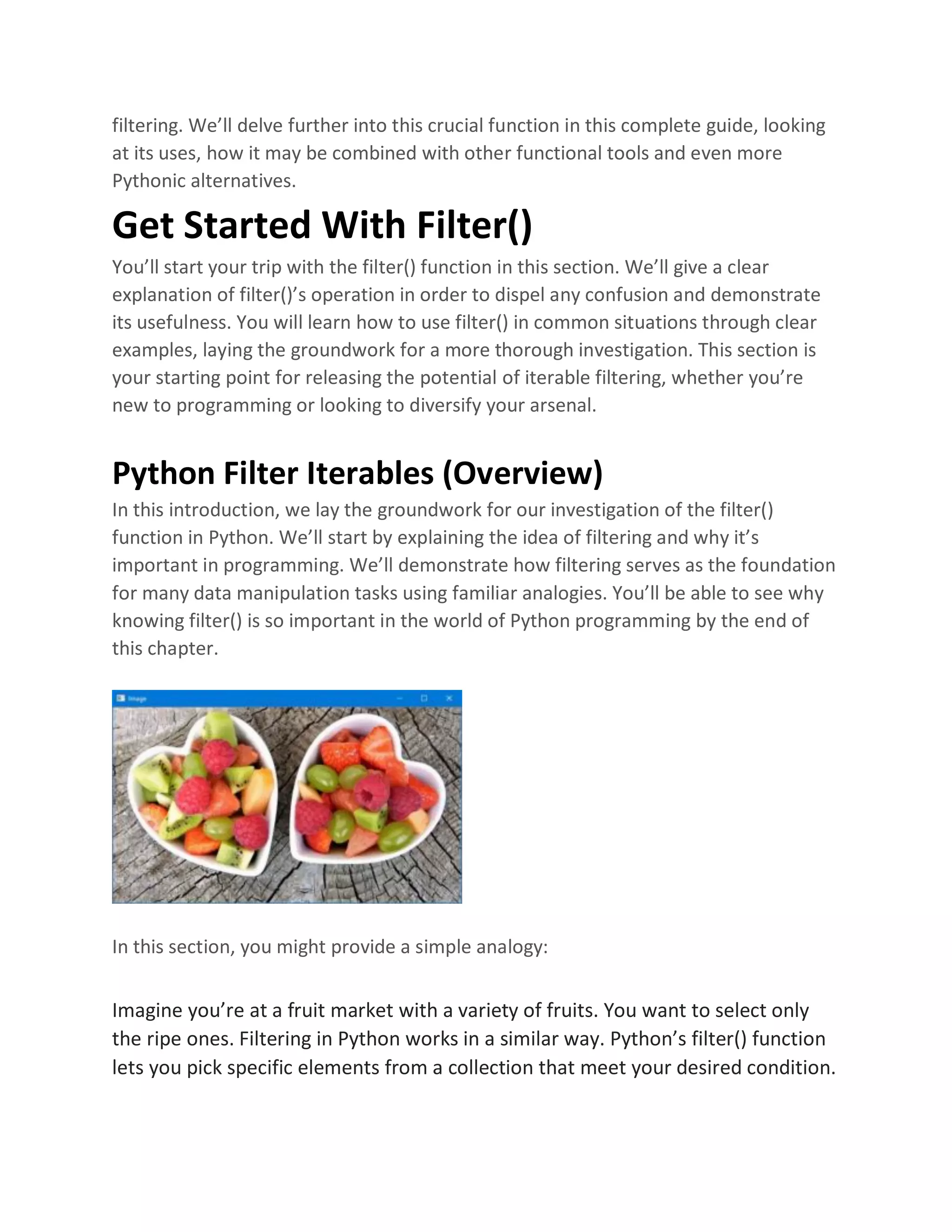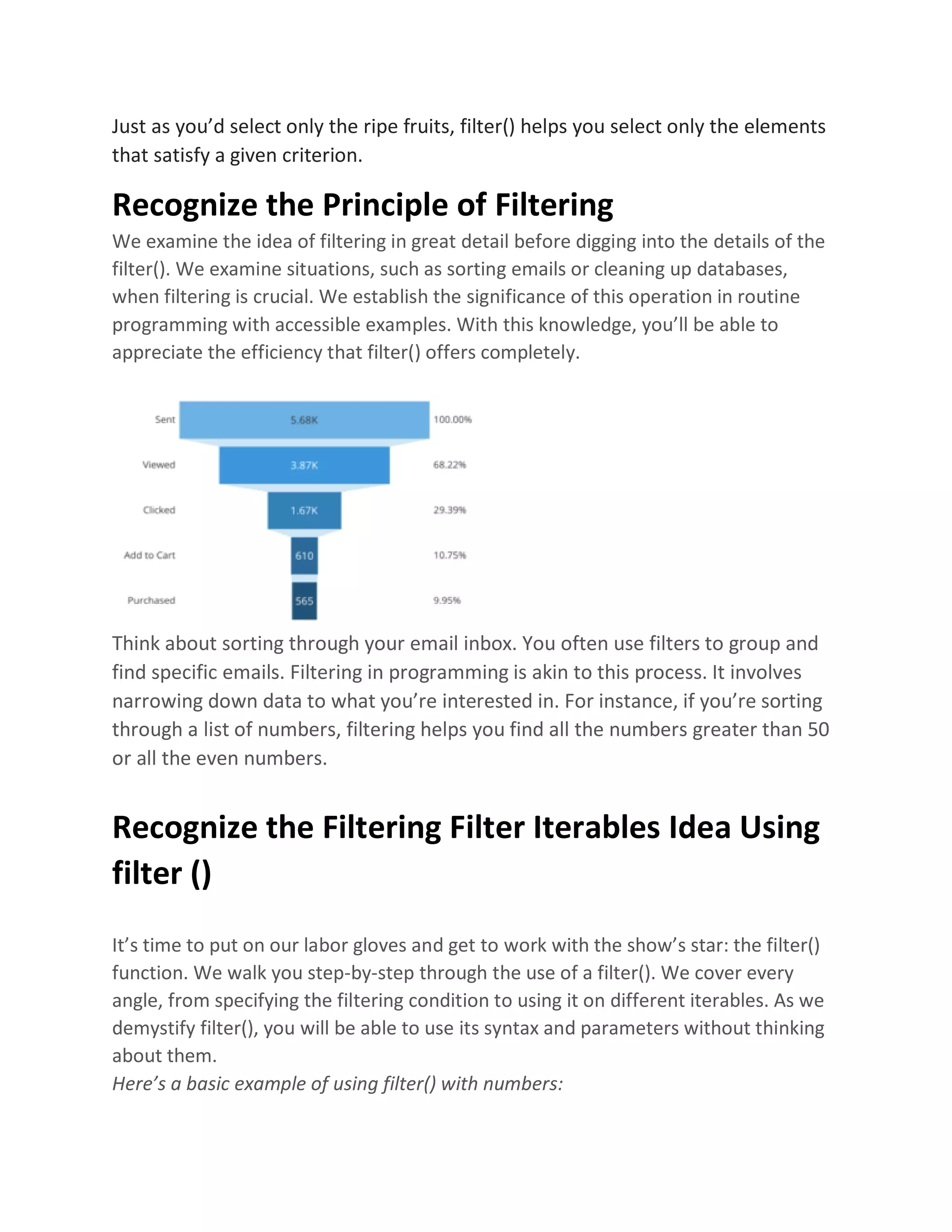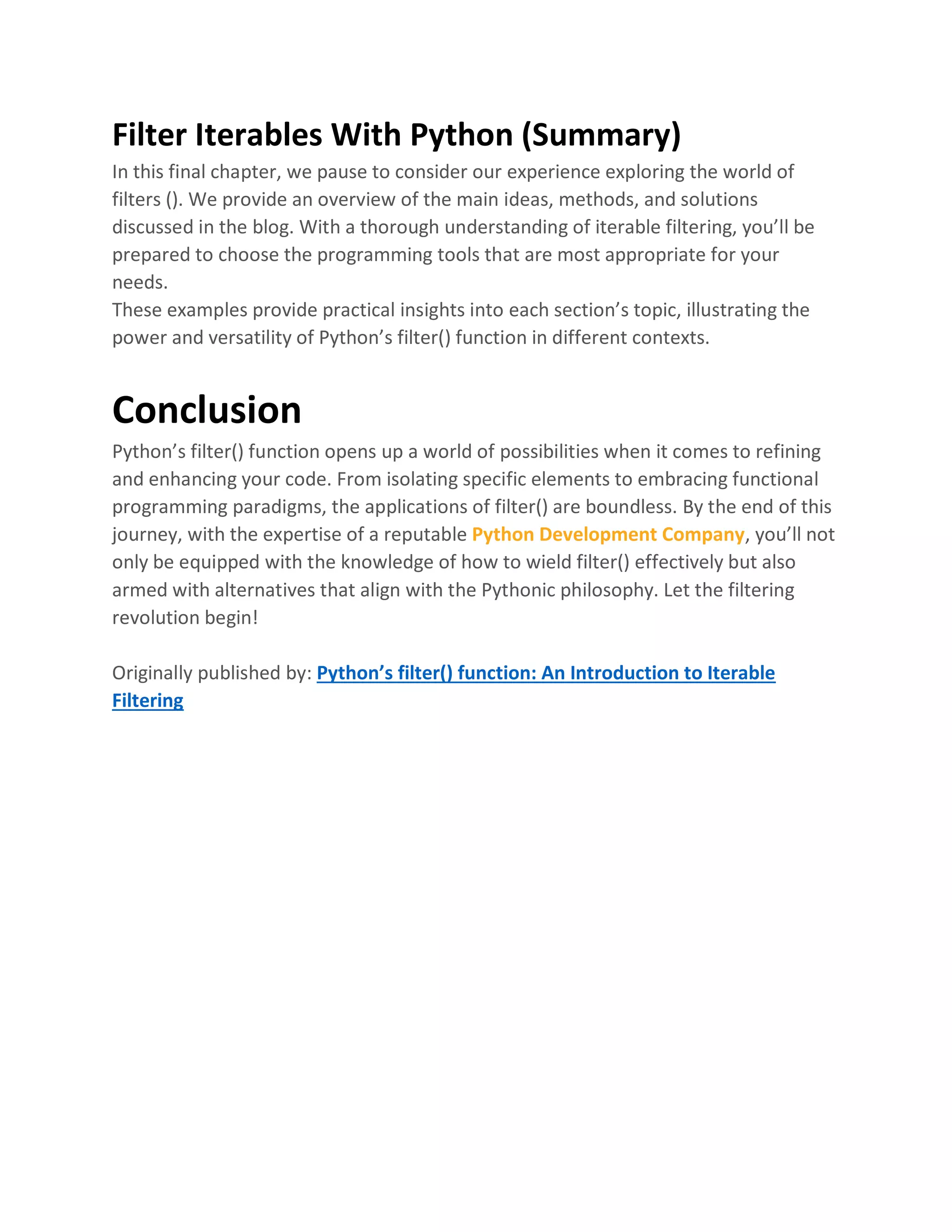The document is a comprehensive guide on Python's filter() function, illustrating its importance in iterable filtering and data manipulation. It covers practical examples, the integration of lambda functions, and introduces alternatives like list comprehensions and generators. By the end, readers will understand how to leverage filter() effectively while exploring advanced techniques and paradigms in Python programming.



![def is_positive(x):
return x > 0numbers = [-3, 7, -12, 15, -6]
positive_numbers = list(filter(is_positive, numbers))
print(positive_numbers) # Output: [7, 15]
Get Even Numbers
By concentrating on a practical task—extracting even integers from a list—in this
hands-on tutorial, we improve our grasp of filter(). We guide you through the
procedure, thoroughly outlining each step. You’ll discover how to create filtering
criteria that meet certain needs through code examples and explanations. By the end
of this chapter, filtering won’t simply be theoretical; it’ll be a skill you can use
immediately.
Extracting even numbers using filter():
def is_even(x):
return x % 2 == 0numbers = [3, 8, 11, 14, 9, 6]
even_numbers = list(filter(is_even, numbers))
print(even_numbers) # Output: [8, 14, 6]
Look for Palindrome Strings
By extending filter(), we turn our attention away from numbers and take on the
exciting task of recognizing palindrome strings. This section highlights the function’s
adaptability by illustrating how it can be used with various data kinds and
circumstances. You’ll learn how to create customized filtering functions that address
particular situations, strengthening your command of filters ().
Filtering palindrome strings using filter():
def is_palindrome(s):
return s == s[::-1]words = [“radar”, “python”, “level”, “programming”]
palindromes = list(filter(is_palindrome, words))
print(palindromes) # Output: [‘radar’, ‘level’]](https://image.slidesharecdn.com/pythonsfilterfunctionanintroductiontoiterablefiltering-231002095836-e6509e13/75/Python-s-filter-function-An-Introduction-to-Iterable-Filtering-4-2048.jpg)
![For Functional Programming, use filter().
As we combine the elegance of lambda functions with the filter() concepts, the world
of functional programming will open up to you. According to functional
programming, developing code that resembles mathematical functions improves
readability and reuse. You’ll learn how to use the advantages of filter() and lambda
functions together to write concise and expressive code through practical examples.
You’ll be able to incorporate functional paradigms into your programming by the
time you finish this chapter.
Code With Functional Programming
This section examines how the functional programming paradigm and filter()
interact. We describe the idea of functional programming and show how filter() fits
in perfectly with its tenets. When lambda functions are integrated with filter(), it
becomes possible to create filtering criteria that are clear and expressive. You’ll see
how this pairing enables you to create code that is both effective and elegant.
Combining filter() with a lambda function:
numbers = [2, 5, 8, 11, 14]
filtered_numbers = list(filter(lambda x: x % 3 == 0, numbers))
print(filtered_numbers) # Output: [5, 11, 14]
Learn about Lambda Functions
We devote a section to the study of lambda functions, which occupy center stage.
We examine the structure of lambda functions, demonstrating their effectiveness
and simplicity. With a solid grasp of lambda functions, you’ll be able to design
flexible filtering conditions that effectively express your criteria. This information
paves the way for creating more intricate and specific filter() processes.
Creating a lambda function for filtering:
numbers = [7, 10, 18, 22, 31]
filtered_numbers = list(filter(lambda x: x > 15 and x % 2 == 0, numbers))
print(filtered_numbers) # Output: [18, 22]](https://image.slidesharecdn.com/pythonsfilterfunctionanintroductiontoiterablefiltering-231002095836-e6509e13/75/Python-s-filter-function-An-Introduction-to-Iterable-Filtering-5-2048.jpg)
![Map() and filter() together
Prepare for the union of filter() and map, two potent functions (). We provide
examples of how these functions work well together to change data. You’ll see via
use cases how combining these techniques can result in code that is clear and
effective that easily manipulates and extracts data from iterables. You won’t believe
the level of data manipulation skill revealed in this part.
Combining filter() and map() for calculations:
numbers = [4, 7, 12, 19, 22]
result = list(map(lambda x: x * 2, filter(lambda x: x % 2 != 0, numbers)))
print(result) # Output: [14, 38, 44]
Combine filter() and reduce()
When we explore intricate data reduction scenarios, the interplay between filter()
and reduce() comes into focus. We demonstrate how applying filters and decreasing
data at the same time can streamline your code. This part gives you the knowledge
you need to handle challenging problems and demonstrates how filter() is used for
more complex data processing than just basic extraction.
Using reduce() along with filter() for cumulative multiplication:
from functools import reduce
numbers = [2, 3, 4, 5]
product = reduce(lambda x, y: x * y, filter(lambda x: x % 2 != 0, numbers))
print(product) # Output: 15
Use filterfalse() to filter iterables.
Each coin has two sides, and filters are no different (). the inverse of filter,
filterfalse() (). We discuss situations where you must omit things that satisfy a
particular requirement. Knowing when to utilize filterfalse() and how to do so will
help you be ready for data manipulation tasks that call for an alternative viewpoint.
Once you realize the full power of iterative manipulation, your toolbox grows.](https://image.slidesharecdn.com/pythonsfilterfunctionanintroductiontoiterablefiltering-231002095836-e6509e13/75/Python-s-filter-function-An-Introduction-to-Iterable-Filtering-6-2048.jpg)
![Using filterfalse() to exclude elements:
from itertools import filterfalse
numbers = [1, 2, 3, 4, 5]
non_even_numbers = list(filterfalse(lambda x: x % 2 == 0, numbers))
print(non_even_numbers) # Output: [1, 3, 5]
List comprehension should be used instead of
filter().
As we introduce the idea of list comprehensions as an alternative to filter, get ready
to see a metamorphosis (). Here, we show how list comprehensions can streamline
your code and improve its expressiveness. List comprehensions are a mechanism for
Python to filter iterables by merging iteration with conditionality. You’ll leave with a
flexible tool that improves readability and effectiveness.
Using list comprehension to filter even numbers:
numbers = [6, 11, 14, 19, 22]
even_numbers = [x for x in numbers if x % 2 == 0]
print(even_numbers) # Output: [6, 14, 22]
Extract Even Numbers With a Generator
As we investigate the situations where generators can take the role of filter(), the
attraction of generators beckons. The advantages of generators are discussed, and a
thorough comparison of generator expressions and filters is provided (). We
demonstrate how to use generators to extract even numbers, which broadens your
toolkit and directs you to the best answer for particular data manipulation problems.
Using a generator expression to filter even numbers:
numbers = [5, 8, 12, 15, 18]
even_numbers = (x for x in numbers if x % 2 == 0)
print(list(even_numbers)) # Output: [8, 12, 18]](https://image.slidesharecdn.com/pythonsfilterfunctionanintroductiontoiterablefiltering-231002095836-e6509e13/75/Python-s-filter-function-An-Introduction-to-Iterable-Filtering-7-2048.jpg)
